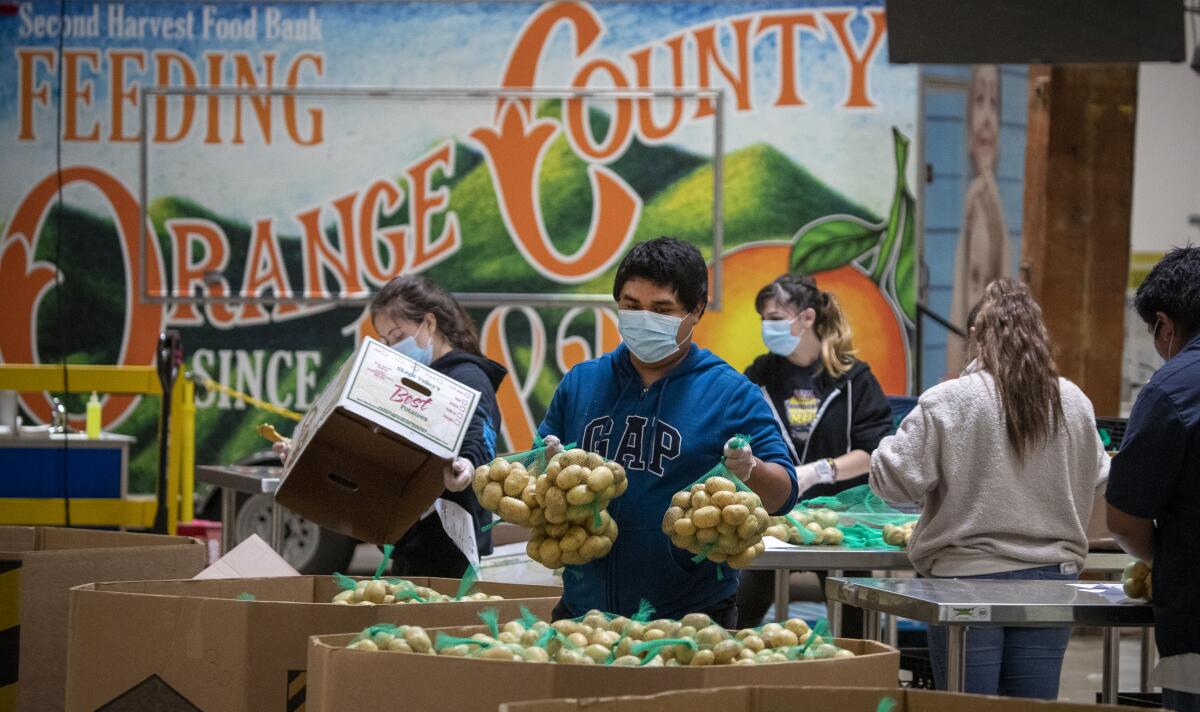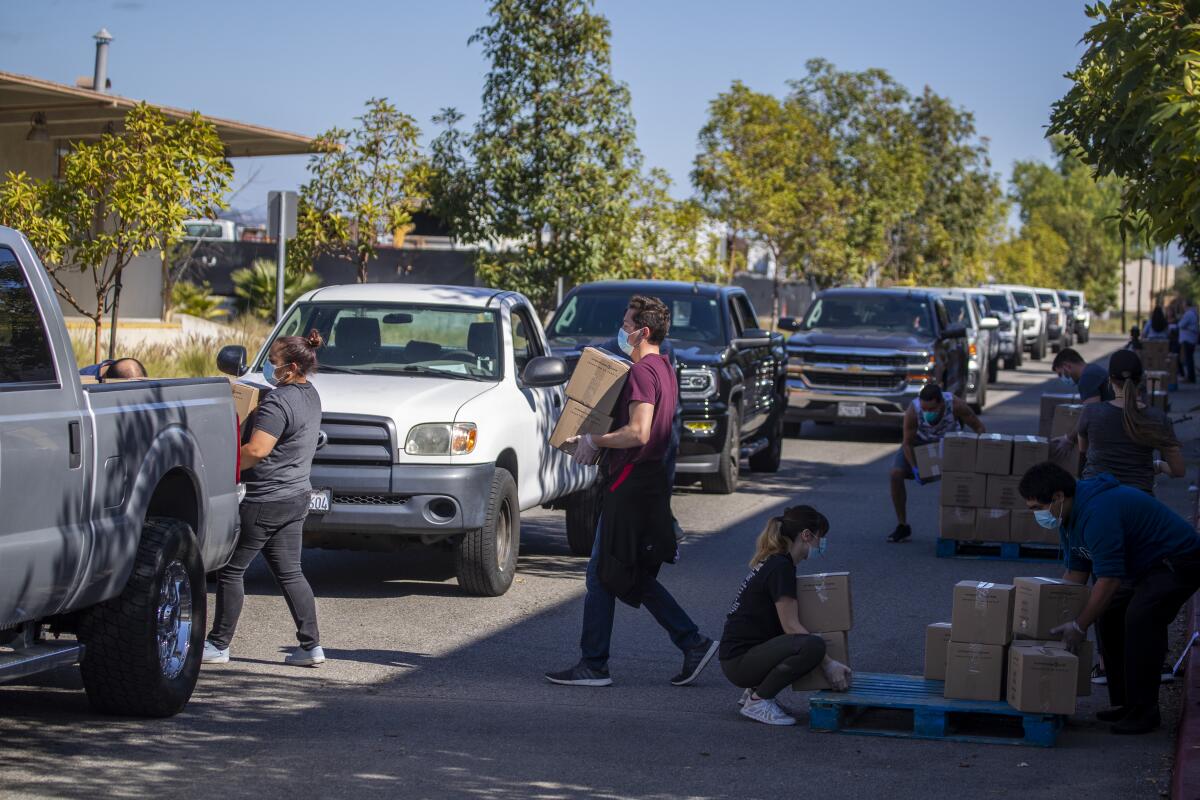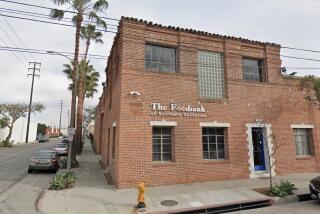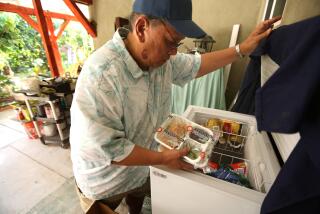Coronavirus reduced its workforce and supplies but O.C. food bank finds a way to help

- Share via
A crew of workers descended this week on the Second Harvest Food Bank of Orange County to pack boxes of food for those in need.
A month ago, none of these workers would have been there. The program they were hired to staff didn’t even exist.
Like virtually all public and private organizations, the Irvine-based nonprofit has had to dramatically retool its operations in a coronavirus pandemic world where “business as usual” is fast becoming a distant memory.
It’s been a challenge but a necessary one — particularly as an increasing number of people find themselves out of work and schools keep their doors closed.
“Food banks across the nation cannot fail,” Second Harvest Chief Executive Harald Herrmann said Wednesday.
The latest updates from our reporters in California and around the world
As the coronavirus began its global spread, the team at Second Harvest sprang into action.
“We started crisis planning in late February and started buying truckloads of shelf-stable food, anticipating what would be coming our way,” Herrmann said.
The organization did so with the expectation — ultimately realized — that the tap could tighten on one of its largest reliable sources of donated food: “grocery rescue” items that have reached their sell-by date but are still safe to consume.

Second Harvest — which provides food to more than 250,000 children, families and seniors in Orange County each month through a network of partner agencies and programs — also had to largely move away from purchasing and providing perishable foods in favor of goods that can safely sit on a pantry shelf.
“[That] was really, for us, a shift overnight to stop what we were doing and move in a different direction,” Herrmann said.
Despite the upheaval, he said the food bank has thus far been able to keep its larders well-stocked.
“We have a five-week supply of food,” he said. “We absolutely have the inventory, we have the distribution methodology to be able to feed Orange County during this crisis.”
Figuring out how to connect those supplies to the people who needed them, however, was another puzzle the food bank had to solve.
Many sites where Second Harvest would normally drop off food deliveries are no longer accessible. Dozens of food pantries countywide have closed their doors in recent weeks.
The food bank’s army of volunteers — which made up about 42% of its workforce pre-coronavirus — has withered as a result of local, county and state health orders for people to stay home and keep from clustering in crowds.
To fill in the gap, Second Harvest has brought on more than 100 part-time employees, some of whom have been laid off from their regular jobs, to pack thousands of bags and boxes with enough food to feed an individual or family for days at a time.
These are some of the unusual new scenes across the Southland during the coronavirus outbreak.
To help distribute the packages, the organization launched its Harvest Truck Brigade, a volunteer fleet of pickup truck drivers who ferry food directly to those who need it.
“We can get a call routed to us from ... a senior or someone who has critical needs and cannot get out of the house to get food, and we can literally take that information and have a box of food delivered to that individual within 24 to 48 hours — door-to-door at no cost,” Herrmann said.
To connect other Orange County residents with the food they need, Second Harvest also has created a weekly drive-through pickup service at the Honda Center in Anaheim. There, people can pull up, have their vehicles loaded with food and be on their way.
That service started two weeks ago, and 3,932 cars drove through Saturday. This weekend, Herrmann said they’re “bracing for somewhere between 5,000 and 6,000.”
All of these new efforts come at a significant cost to Second Harvest. Herrmann estimated an additional $340,000 a week is needed to keep up with the demand of the programs.
Anyone who’s interested in donating, or learning more about the food bank, can visit feedoc.org.
While predictions change daily on how long the coronavirus-fueled crisis will last, Herrmann said Second Harvest is anticipating mid-April through mid-June will be the most challenging stretch for its operations.
In the meantime, the organization will keep rolling with the punches.
“There is no manual, there’s no playbook, there’s no mentor you can call, there’s no advisor,” Herrmann said. “This is basically, ‘Figure it out as you go, learn as much as you can as quickly as you can ... and keep moving.’ ”
More to Read
Sign up for Essential California
The most important California stories and recommendations in your inbox every morning.
You may occasionally receive promotional content from the Los Angeles Times.













